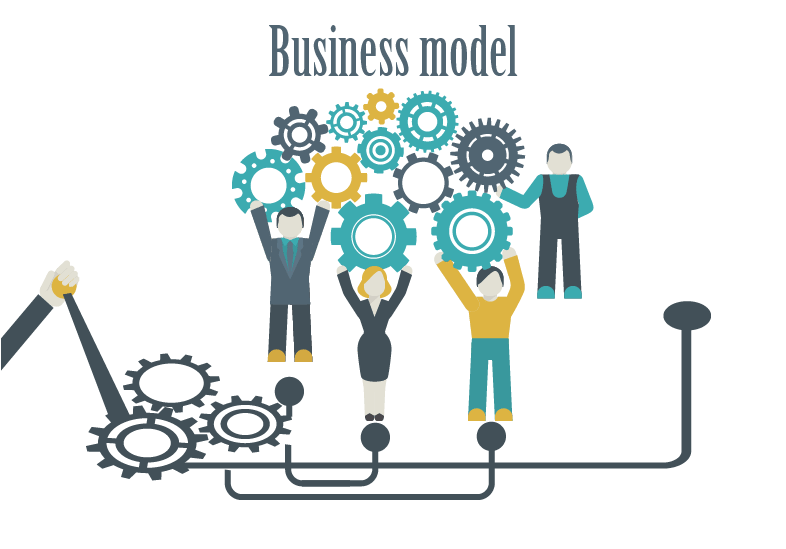A business model is a framework that shows how a business creates value, delivers that value to customers, and profits from it. Choosing the right business model is one of the key factors in the success of a business. In the following, some of the most common types of business models and their applications will be introduced:
1.Freemium model
Explanation: In this model, the company offers a free version of its product or service and provides basic features to users for free. It then charges users to access more advanced features and services.
Applications:
Software companies: Many applications and online services such as Spotify, Dropbox, and LinkedIn use this model.
Digital services: This model is very useful in services that need a base of users to become profitable with the growth of the number of users.
- Subscription model
Explanation: In the subscription model, instead of buying a product or service once, customers pay a monthly or annual fee to use the service or product continuously. This model makes companies have a stable and continuous income stream.
Applications:
Streaming services: Netflix, HBO Max, and Spotify use this model to deliver their media content.
SaaS software: Companies like Adobe and Microsoft use this model to provide their software to customers.
- Marketplace model
Description: Marketplace is a platform that connects sellers and buyers. This model does not provide a product or service per se, but charges a fee for each transaction by providing a safe space for interactions.
Applications:
Online stores: Amazon and eBay use this model and act as an intermediary between buyers and sellers.
Travel and rental services: Airbnb and Uber use this model to connect travelers with drivers or hosts.
- Advertising model
Explanation: In the advertising model, companies earn money from advertisers instead of charging users. This model is used in free services to users and advertisers pay to access the audience of these platforms.
Applications:
Social networks: Facebook and Instagram use this model to earn money.
Search engines: Google uses this model and earns money through advertising in search results.
- Dropshipping model
Explanation: In this model, stores do not purchase products directly from the manufacturer or supplier. Rather, only when the customer places an order, the store sends the order to the supplier, and the supplier ships the product directly to the customer.
Applications:
Small online stores: Many online stores with little initial capital use this model to reduce risk and inventory costs.
E-commerce: This model allows companies to offer products to customers without the need for warehousing or direct shipping.
- Product as a Service (PaaS) model
Explanation: In this model, instead of selling products at once, products are offered as a service. Instead of buying the product, customers use it and pay periodically.
Applications:
SaaS software: Many software such as Microsoft Office 365 use this model.
Business Services: Companies such as Xerox that rent printing machines to customers.
- Build to Order model
Explanation: In this model, products are produced only when the order is registered by the customer. This model helps companies avoid wasting resources and respond to specific customer needs.
Applications:
Car manufacturing: Companies like Tesla use this model to customize and manufacture cars based on customer needs.
Electronics: Companies like Dell initially used this model to produce personal computers.
- Reverse Freemium model
Explanation: In this model, customers first pay to use a service or product, but after more uses or reaching a certain volume of services, they receive free access or lower costs.
Applications:
Cloud services: Companies like AWS use this model to attract large and stable customers.
SaaS platforms: Some platforms use this model to attract large customers and create long-term commitment.
- Franchise model
Explanation: In this model, a parent company allows other individuals or companies to start their own businesses using its brand name, products, and business processes. In return, the parent company receives fees including an initial royalty and a percentage of sales.
Applications:
Chain restaurants: McDonald’s and KFC use this model to expand their business around the world.
Services: Brands such as Hilton hotels and Molly Maid cleaning services use this model.
- Leasing model
Explanation: In the leasing model, instead of buying the product, customers rent it for a certain period of time. This model is very suitable for expensive goods that require a lot of capital to buy.
Applications:
Automotive industry: Many car manufacturing companies and car dealerships use this model to rent cars to customers.
Heavy Machinery: Companies like Caterpillar that lease heavy industrial equipment to construction and mining companies.
Each of these business models has its advantages and disadvantages, and their choice depends on the type of business, the target market and the overall strategy of the company. A detailed understanding of these models will help entrepreneurs and managers

